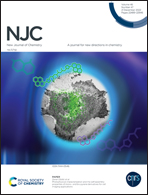Polyethylenimine-functionalized mesoporous silica-chitosan composites and their ability to adsorb Pb(ii)†
Abstract
There is an urgent need to reduce heavy metal contamination of the environment because the ions can accumulate in living organisms, yet the lack of highly efficient and cost-effective treatment methods remains. In this study, polyethylenimine (PEI)-functionalized mesoporous silica–chitosan composites were synthesized via a microwave-assisted method, and it was applied for the removal of Pb(II). Inexpensive sodium silicate and chitosan were chosen as precursors to construct a basic mesoporous silica–chitosan skeleton. Epichlorohydrin (ECH) was used to further cross-link PEI molecules onto the porous substrate. PEI played a critical role in the adsorption of Pb(II) and was beneficial because its multiple N atoms coordinated with the metal ions. The adsorbent CK-T50/t20-m0.2 exhibited the strongest adsorption performance, of which the capacity for Pb(II) reached 279.08 mg g−1. After six adsorption–desorption cycles, the capacity was preserved at 94.7%, and the regeneration rate reached 93%, demonstrating its satisfactory stability and cyclic performance. The effect of pH, adsorption kinetics, adsorption isotherms, and thermodynamics of the process were also studied. The adsorbent is a promising material for use in practical applications of heavy metal removal.



 Please wait while we load your content...
Please wait while we load your content...